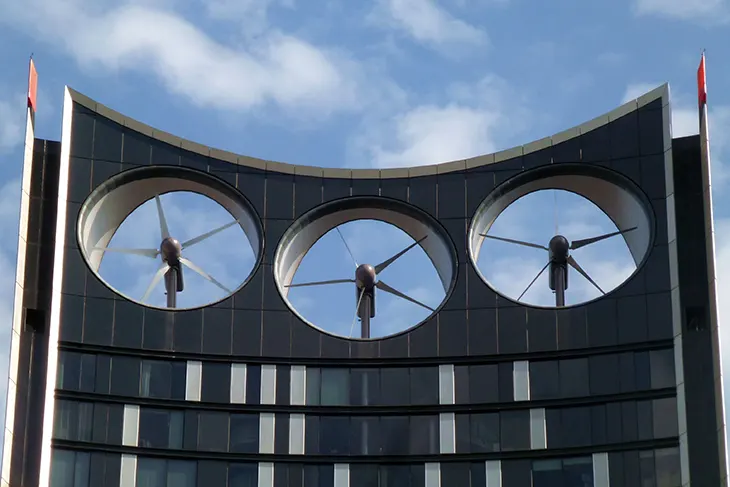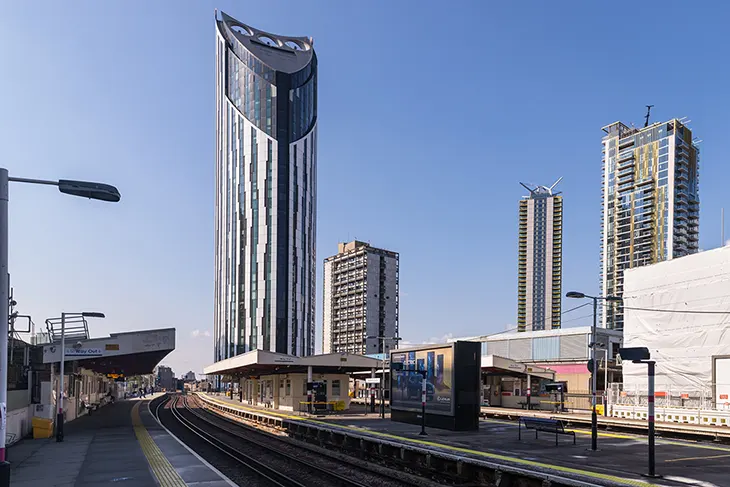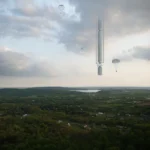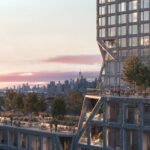
The pursuit of sustainable cities has driven architects and urban planners to explore ever more innovative solutions for on-site renewable energy. Among these, urban wind turbines, compact, design-integrated generators, have captured the imagination of the sustainability-focused design community.
But are they truly viable as architectural elements in the dense, complex environments of our cities? ARCHISCENE Magazine’s Editor In Chief Zarko Davinic explores:
A Growing Interest in Urban Micro Wind Energy
As cities race to decarbonize and reduce reliance on fossil fuels, the idea of harnessing wind power at the building scale is gaining renewed attention. Micro wind turbines, designed for urban settings, promise to turn rooftops and facades into small-scale energy generators. Their appeal is clear: they offer the potential for localized, visible renewable energy production that can be integrated into a building’s identity and narrative.
However, the path from concept to reality is far from straightforward. While solar panels have become a common sight, urban wind turbines remain rare, often limited to demonstration projects or high-profile case studies.
Architectural and Regulatory Challenges
The unique conditions of urban environments present significant challenges for wind energy. Buildings create turbulence, wind speeds are highly variable, and available space is at a premium. Noise and vibration, aesthetic concerns, and stringent zoning regulations further complicate the integration of turbines into architectural projects.
The Strata SE1 building in London, designed by BFLS, stands as a cautionary tale and a landmark experiment in this field. Completed in 2010, Strata SE1 was the first residential tower in the world to incorporate wind turbines as an integral part of its design. The three nine-metre-diameter turbines, dramatically perched atop the 148-metre-high tower, were intended to generate up to 50 megawatt-hours of electricity annually, covering an estimated 8% of the building’s total energy consumption.
Yet, the reality has proven far more complex. Residents and neighbors quickly complained about noise and vibration, and the turbines’ actual energy contribution fell short of expectations. Over time, reports suggest the turbines have been used rarely, if at all, and today they remain largely symbolic, a striking visual statement, but not a functional source of renewable energy.
Lessons from Strata SE1: The Importance of Accurate Assessment
The Strata SE1 experience highlights the critical importance of accurate wind resource assessment in urban environments. Unlike open fields or coastal sites, cities are defined by their unpredictability: wind speeds are inconsistent, and airflow is disrupted by countless obstacles. Without rigorous, site-specific analysis, even the most promising urban wind project can fall short. Furthermore, the actual amount of power produce is paramount. In the case of Strata the meer 8% has exceeded any benefits of the continuous use of the turbines.
This is where advanced simulation tools come into play. Computational Fluid Dynamics (CFD) software, such as UrbaWind®, a Meteodyn’s software, enables architects and engineers to model wind flows at a hyper-local scale. These tools help predict turbulence, identify optimal turbine placement, and estimate realistic energy yields, crucial steps for any viable urban wind project. With more accessible and accurate simulation technology, the risk of costly missteps like those seen at Strata SE1 can be significantly reduced.
Design, Aesthetics, and the Urban Experience
Beyond technical viability, there’s the matter of aesthetics and urban experience. Wind turbines are mechanical objects, moving, sometimes noisy, and visually prominent. Integrating them into a building’s design requires a delicate balance between function and form. Designers must consider not only the building’s users but also the wider community, whose experience of the urban landscape may be shaped by these kinetic elements.

Strata SE1’s bold silhouette is a great starting point to the potential for wind turbines to become architectural icons. However, the building’s operational challenges underscore the need for realistic expectations and transparent communication with stakeholders. In cities where space and attention are both limited, design solutions must be as sensitive as they are innovative.
Regulatory Hurdles and Community Acceptance
Zoning laws and building codes often present additional hurdles. Many cities have strict regulations regarding rooftop equipment, noise levels, and structural safety. Gaining approval for urban wind turbines can be a lengthy process, requiring extensive documentation and, often, community engagement to address concerns about noise, aesthetics, and perceived safety.
Community acceptance is crucial. As Strata SE1 demonstrates, even the best-intentioned green infrastructure can spark opposition if it disrupts daily life or fails to deliver on its promises. Future projects must prioritize stakeholder engagement and clear communication about both the benefits and limitations of urban wind energy.
New Era for Urban Wind?
Fifteen years after Strata SE1’s debut, no major residential project has replicated its ambitious approach to wind integration. The technical and social challenges remain formidable, but advances in turbine technology and simulation software are making urban wind more feasible than ever before. Quieter, more efficient turbines and improved predictive tools could pave the way for a new generation of design-integrated wind energy solutions.
The question remains: have we reached a turning point? As cities continue to evolve, the integration of renewable energy into the built environment will only become more critical. Urban wind turbines may never be as ubiquitous as solar panels, but with careful planning, realistic expectations, and the right technology, they could yet find their place in the sustainable cityscape.
For more on sustainable and eco-friendly buildings, check out our guide.
Urban wind turbines are not a silver bullet, but with smarter design, better tools, and a commitment to learning from the past, they might just help shape the greener cities of tomorrow.



